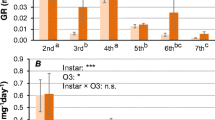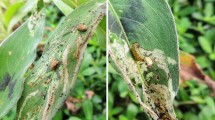Abstract
The effects of feeding on root by the larvae and three types of Momordica cochinchinensis Spreng (Cucubitaceae) leaves (young, mature and senescent) by the adults of Aulacophora foveicollis Lucas (Coleoptera: Chrysomelidae) were studied under laboratory conditions. Total larval developmental time was 19.7 ± 0.2 days by feeding on young roots. Adult males lived for 28.4 ± 1, 65.7 ± 1.1 and 22.8 ± 1.3 days on young, mature and senescent leaves, respectively; whilst adult females lived for 34.3 ± 1.2, 68.5 ± 0.9 and 26.4 ± 1.4 days on young, mature and senescent leaves, respectively. Fecundity was highest in mature leaves fed insects (202.2 ± 10.6). Total carbohydrate, protein, lipid, nitrogen and amino acid were much higher in root followed by mature leaves than young and senescent leaves. Moisture content was highest in mature leaves than the roots, young and senescent leaves. Phenols were greatest in young leaves followed by mature leaves and least in senescent leaves and roots of the said plant. Flavonols were higher in young leaves and least in root. These results suggest that A. foveicollis adults perform better on mature leaves than young and senescent leaves for their nutrition.



Similar content being viewed by others
References
Abe, M., and K. Matsuda. 2005. Chemical factors influencing the feeding preference of three Aulacophora leaf beetle species (Coleoptera: Chrysomelidae). Applied Entomology and Zoology 40: 161–168.
Al-Ali, A.S., I.K. Al-Neamy, and M.S. Alwan. 1982. On the biology and host preference of Aulacophora foveicollis Lucas (Coleoptera, Galerucidae). Zeitschrift für Angewandte Entomologie 94: 82–86.
Alikhan, M.A., and M. Yousuf. 1985. Effect of host on the oviposition and development and survival of the larvae of Aulacophora foveicollis Lucas (Chrysomelidae, Coleoptera). Canadian Journal of Zoology 63: 1634–1637.
Bray, H.G., and W.V. Thorpe. 1954. Analysis of phenolic compounds of interest in metabolism. Methods of Biochemical Analysis 1: 27–52.
Burke, D.S., C.R. Smidt, and L.T. Vuong. 2005. Momordica cochinchinensis, Rosa roxburghii, Wolfberry, and Sea buckthorn-highly nutritional fruits supported by tradition and science. Current Topics in Nutraceutical Research 3: 259–266.
Chuyen, H.V., M.H. Nguyen, P.D. Roach, J.B. Golding, and S.E. Parks. 2015. Gac fruit (Momordica cochinchinensis Spreng.): a rich source of bioactive compounds and its potential health benefits. International Journal of Food Science and Technology 50: 567–577.
DuBios, M., K.A. Gilles, J.K. Hamilton, P.A. Rebers, and F. Smith. 1956. Colorimetric method for determination of sugars and related substances. Analytical Chemistry 28: 350–356.
Folch, J., M. Lees, and G.H. Sloane-Stanley. 1957. A simple method for the isolation and purification of total lipids from animal tissues. Journal of Biological Chemistry 226: 497–509.
Genc, H., and J.L. Nation. 2004. Influence of dietary lipids on survival of Phyciodes phaon butterflies (Lepidoptera: Nymphalidae). Journal of Entomological Science 39: 537–544.
Harborne, J.B. 2003. Introduction to Ecological Biochemistry. London: Academic Press.
Hazewindus, M., G.R.M.M. Haenen, A.R. Weseler, and A. Bast. 2012. The anti-inflammatory effect of lycopene complements the antioxidant action of ascorbic acid and α-tocopherol. Food Chemistry 132: 954–958.
Howell, C.R., A.A. Bell, and R.D. Stipanovic. 1976. Effect of aging on flavonoid content and resistance of cotton leaves to Verticillium wilt. Physiological Plant Pathology 8: 181–188.
Humphries, E.C. 1956. Nitrates. In Modern methods of plant analysis, ed. K. Peach, and M.V. Tracey, 481–483. Germany: Springer.
Ishida, B.K., C. Turner, M.H. Chapman, and T.A. McKeon. 2004. Fatty acid and carotenoid composition of gac (Momordica cochinchinensis Spreng) fruit. Journal of Agriculture and Food Chemistry 52: 274–279.
Khan, M.M.H., M.Z. Alam, and M.M. Rahman. 2011. Host preference of red pumpkin beetle in a choice test under net case condition. Bangladesh Journal of Zoology 39: 231–234.
Kubola, J., and S. Siriamornpun. 2011. Phytochemicals and antioxidant activity of different fruit fractions (peel, pulp, aril and seed) of Thai gac (Momordica cochinchinensis Spreng). Food Chemistry 127: 1138–1145.
Kubola, J., N. Meeso, and S. Siriamornpun. 2013. Lycopene and beta carotene concentration in aril oil of gac (Momordica cochinchinensis Spreng) as influenced by aril-drying process and solvents extraction. Food Research International 50: 664–669.
Lowry, O.H., N.J. Rosebrough, A.L. Farr, and R.J. Randall. 1951. Protein measurement with the folin phenol reagent. Journal of Biological Chemistry 193: 265–275.
Mai, H.C., V. Truong, and F. Debaste. 2013a. Optimization of enzyme-assisted extraction of oil rich in carotenoids from Gac fruit (Momordica cochinchinensis Spreng.). Food Technology and Biotechnology 51: 488–499.
Mai, H.C., V. Truong, B. Haut, and F. Debaste. 2013b. Impact of limited drying on Momordica cochinchinensis Spreng. aril carotenoids content and antioxidant activity. Journal of Food Engineering 118: 358–364.
Meng, L.Y., H.R. Liu, Y. Shen, Y.Q. Yu, and X. Tao. 2011. Cochinchina momordica seed extract induces G2/M arrest and apoptosis in human breast cancer MDA-MB-231 cells by modulating the PI3 K/Akt pathway. Asian Pacific Journal of Cancer Prevention 12: 3483–3488.
Moore, S., and W.H. Stein. 1948. Photometric ninhydrin method for use in the chromatography of amino acids. The Journal of biological chemistry 176: 367–388.
Mordente, A., B. Guantario, E. Meucci, A. Silvestrini, E. Lombardi, G.E. Martorana, B. Giardina, and V. Böhm. 2011. Lycopene and cardiovascular diseases: An update. Current Medicinal Chemistry 18: 1146–1163.
Mukherjee, A., N. Sarkar, and A. Barik. 2014. Long-chain free fatty acids from Momordica cochinchinensis leaves as attractants to its insect pest, Aulacophora foveicollis Lucas (Coleoptera: Chrysomelidae). Journal of Asia-Pacific Entomology 17: 229–234.
Mukherjee, A., N. Sarkar, and A. Barik. 2015a. Momordica cochinchinensis (Cucurbitaceae) leaf volatiles: semiochemicals for host location by the insect pest, Aulacophora foveicollis (Coleoptera: Chrysomelidae). Chemoecology 25: 93–104.
Mukherjee, A., N. Sarkar, and A. Barik. 2015b. Leaf surface n-alkanes of Momordica cochinchinensis Spreng as short-range attractants for its insect pest, Aulacophora foveicollis Lucas (Coleoptera: Chrysomelidae). Allelopathy Journal 36: 109–122.
Nation, J.L. 2001. Insect physiology and biochemistry. Boca Raton: CRC Press.
Parks, S.E., C.T. Murray, D.L. Gale, B. Al-Khawaldeh, and L.J. Spohr. 2013. Propagation and production of Gac (Momordica cochinchinensis Spreng.), a greenhouse case study. Experimental Agriculture 49: 234–243.
Pavlakos, J.G. 1943. The biology and control of Aulacophora foveicollis, Luc. in Greece. Zeitschrift fur Angewandte Entomologie 30: 1–78.
Rahaman, M.A., and M.D.H. Prodhan. 2007. Effects of net barrier and synthetic pesticides on Red pumpkin beetle and yield of cucumber. International Journal of Sustainable Crop Production 2: 30–34.
Roy, N., and A. Barik. 2012. The impact of variation in foliar constituents of sunflower on development and reproduction of Diacrisia casignetum Kollar (Lepidoptera: Arctiidae). Psyche: A Journal of Entomology. doi:10.1155/2012/812091.
Roy, N., and A. Barik. 2013. Influence of four host-plants on feeding, growth and reproduction of Diacrisia casignetum (Lepidoptera: Arctiidae). Entomological Science 16: 112–118.
Santhosh Kumar, K., and L. Nadarajan. 2008. Evidence of female-produced sex pheromone in red pumpkin beetle, Aulacophora foveicollis Lucas (Coleoptera: Chrysomelidae). Current Science 94: 1369–1371.
Schoonhoven, L.M., J.J.A. van Loon, and M. Dicke. 2005. Insect-plant biology. New York: Oxford University Press.
Shobana, K., K. Murugan, and A. Naresh Kumar. 2010. Influence of host plants on feeding, growth and reproduction of Papilio polytes (the common mormon). Journal of Insect Physiology 56: 1065–1070.
Singh, D., and C.K. Gill. 1979. Estimation of losses in growth and yield of muskmelon due to Aulacophora foveicollis (Lucas). Indian Journal of Entomology 44: 294–295.
Sinha, A.K., and S.S. Krishna. 1969. Feeding of Aulacophora foveicollis (Lucas) on cucurbitacin. Journal of Economic Entomology 62: 513–514.
Slansky, F., and J.M. Scriber. 1985. Food consumption and utilization. In Comprehensive insect physiology, biochemistry and pharmacology, ed. G.A. Kerkut, and L.I. Gilbert, 87–163. Oxford: Pergamon Press.
Treutter, D. 2006. Significance of flavonoids in plant resistance: A review. Environmental Chemistry Letters 4: 147–157.
Vuong, L.T., A.A. Franke, L.J. Custer, and S.P. Murphy. 2006. Momordica cochinchinensis Spreng (gac) fruit carotenoids reevaluated. Journal of Food Composition and Analysis 19: 664–668.
War, A.R., M.G. Paulraj, T. Ahmad, A.A. Buhroo, B. Hussain, S. Ignacimuthu, and H.C. Sharma. 2012. Mechanisms of plant defense against insect herbivores. Plant Signaling and Behavior 7: 1306–1320.
Zar, J.H. 1999. Biostatistical analysis. New Jersey: Prentice Hall.
Acknowledgments
We thank anonymous reviewer(s) for many helpful comments for an earlier version of the manuscript. We are thankful to Dr. Poorani Janakiraman, National Bureau of Agriculturally Important Insects (formerly PDBC), Karnataka, India for identifying the insect, and Prof. Ambarish Mukherjee, Dept. of Botany of this University for identification of the plant. The work was supported by the DST FIST, UGC-DRS, New Delhi, India under grant [No. F.3–9/2012 (SAP II)].
Author information
Authors and Affiliations
Corresponding author
Rights and permissions
About this article
Cite this article
Mukherjee, A., Karmakar, A. & Barik, A. Bionomics of Momordica cochinchinensis Fed Aulacophora foveicollis (Coleoptera: Chrysomelidae). Proc Zool Soc 70, 81–87 (2017). https://doi.org/10.1007/s12595-016-0166-y
Received:
Revised:
Accepted:
Published:
Issue Date:
DOI: https://doi.org/10.1007/s12595-016-0166-y




